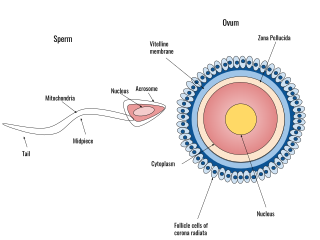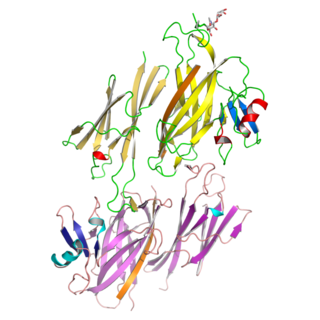Related Research Articles

A spermatozoon is a motile sperm cell, or moving form of the haploid cell that is the male gamete. A spermatozoon joins an ovum to form a zygote.

Fertilisation or fertilization, also known as generative fertilisation, syngamy and impregnation, is the fusion of gametes to give rise to a zygote and initiate its development into a new individual organism or offspring. While processes such as insemination or pollination, which happen before the fusion of gametes, are also sometimes informally referred to as fertilisation, these are technically separate processes. The cycle of fertilisation and development of new individuals is called sexual reproduction. During double fertilisation in angiosperms, the haploid male gamete combines with two haploid polar nuclei to form a triploid primary endosperm nucleus by the process of vegetative fertilisation.

For fertilization to happen between a sperm and egg cell, a sperm must first fuse with the plasma membrane and then penetrate the female egg cell to fertilize it. While the fusion of the sperm cell with the egg cell's plasma membrane is relatively straightforward, penetrating the egg's protective layers, such as the zona pellucida, presents a significant challenge. Therefore, sperm cells go through a process known as the acrosome reaction, which is the reaction that occurs in the acrosome of the sperm as it approaches the egg.

The zona pellucida is the specialized area surrounding mammalian oocytes (eggs). It is also known as an egg coat. The zona pellucida is essential for oocyte growth and fertilization.

Acrosin is a digestive enzyme that acts as a protease. In humans, acrosin is encoded by the ACR gene. Acrosin is released from the acrosome of spermatozoa as a consequence of the acrosome reaction. It aids in the penetration of the Zona Pellucida.
Wildlife contraceptives are contraceptives used to regulate the fertility of wild animals. They are used to control population growth of certain wild animals.

Human fertilization is the union of an egg and sperm, occurring primarily in the ampulla of the fallopian tube. The result of this union leads to the production of a fertilized egg called a zygote, initiating embryonic development. Scientists discovered the dynamics of human fertilization in the 19th century.
In biology, polyspermy describes the fertilization of an egg by more than one sperm. Diploid organisms normally contain two copies of each chromosome, one from each parent. The cell resulting from polyspermy, on the other hand, contains three or more copies of each chromosome—one from the egg and one each from multiple sperm. Usually, the result is an unviable zygote. This may occur because sperm are too efficient at reaching and fertilizing eggs due to the selective pressures of sperm competition. Such a situation is often deleterious to the female: in other words, the male–male competition among sperm spills over to create sexual conflict.

The cortical reaction is a process initiated during fertilization that prevents polyspermy, the fusion of multiple sperm with one egg. In contrast to the fast block of polyspermy which immediately but temporarily blocks additional sperm from fertilizing the egg, the cortical reaction gradually establishes a permanent barrier to sperm entry and functions as the main part of the slow block of polyspermy in many animals.
The vitelline membrane or vitelline envelope is a structure surrounding the outer surface of the plasma membrane of an ovum or, in some animals, the extracellular yolk and the oolemma. It is composed mostly of protein fibers, with protein receptors needed for sperm binding which, in turn, are bound to sperm plasma membrane receptors. The species-specificity between these receptors contributes to prevention of breeding between different species. It is called zona pellucida in mammals. Between the vitelline membrane and zona pellucida is a fluid-filled perivitelline space.

The Catalina Island Conservancy is a nonprofit organization established to protect and restore Santa Catalina Island, California, United States. The Conservancy was established in 1972 through the efforts of the Wrigley and Offield families. The Conservancy was created when both families deeded 42,135 acres (170.51 km2) of the island over to the organization—88% of the Island.

Zona pellucida sperm-binding protein 3, also known as zona pellucida glycoprotein 3 (Zp-3) or the sperm receptor, is a ZP module-containing protein that in humans is encoded by the ZP3 gene. ZP3 is the glycoprotein in the zona pellucida most important for inducting the acrosome reaction of sperm cells at the beginning of fertilization.
Immunocontraception is the use of an animal's immune system to prevent it from fertilizing offspring. Contraceptives of this type are not currently approved for human use.

Zona pellucida sperm-binding protein 2 is a protein that in humans is encoded by the ZP2 gene.
Population control is the practice of artificially maintaining the size of any population. It simply refers to the act of limiting the size of an animal population so that it remains manageable, as opposed to the act of protecting a species from excessive rates of extinction, which is referred to as conservation biology.

Cortical granules are regulatory secretory organelles found within oocytes and are most associated with polyspermy prevention after the event of fertilization. Cortical granules are found among all mammals, many vertebrates, and some invertebrates. Within the oocyte, cortical granules are located along the cortex, the region furthest from the cell's center. Following fertilization, a signaling pathway induces the cortical granules to fuse with the oocyte's cell membrane and release their contents into the oocyte's extracellular matrix. This exocytosis of cortical granules is known as the cortical reaction. In mammals, the oocyte's extracellular matrix includes a surrounding layer of perivitelline space, zona pellucida, and finally cumulus cells. Experimental evidence has demonstrated that the released contents of the cortical granules modify the oocyte's extracellular matrix, particularly the zona pellucida. This alteration of the zona pellucida components is known as the zona reaction. The cortical reaction does not occur in all mammals, suggesting the likelihood of other functional purposes for cortical granules. In addition to modifying the oocyte's extracellular matrix and establishing a block to polyspermy, the exocytosis of cortical granules may also contribute towards protection and support of the developing embryo during preimplantation. Once the cortical granules complete their functions, the oocyte does not replenish them.
Repeated implantation failure (RIF) is the repeated failure of the embryo to implant onto the side of the uterus wall following IVF treatment. Implantation happens at 6–7 days after conception and involves the embedding of the growing embryo into the mothers uterus and a connection being formed. A successful implantation can be determined by using an ultrasound to view the sac which the baby grows in, inside the uterus.
Non-surgical fertility control is the prevention of reproduction without the use of surgery. The most common form of sterilization in dogs and cats is surgical, spaying in females and castration in males. Non-surgical fertility control can either result in sterilization or temporary contraception and could offer a cheaper way to keep wild dog and cat populations under control. As of 2019, only contraceptives are commercially available. Research is ongoing into methods that could result in permanent suppression of fertility.
In biology, overabundant species refers to an excessive number of individuals and occurs when the normal population density has been exceeded. Increase in animal populations is influenced by a variety of factors, some of which include habitat destruction or augmentation by human activity, the introduction of invasive species and the reintroduction of threatened species to protected reserves.
Paul Michael Wassarman is an American biologist who has been Professor in the Dept. of Cell, Developmental, and Regenerative Biology at the Icahn School of Medicine at Mount Sinai since 1996. His laboratory identified and characterised proteins that make up the zona pellucida (ZP) of mammalian eggs and determined their role in fertilisation.
References
- ↑ http://pzpinfo.org Wildlife forever
- ↑ "Reducing Population Growth Rates: Fertility Control in Wild Horse Mares". Archived from the original on 2013-02-01. Retrieved 2013-01-09.
- ↑ Turner, J. W.; Liu, I. K. M.; Flanagan, D. R.; Bynum, K. S.; Rutberg, A. T. (2002). "Porcine zona pellucida (PZP) immunocontraception of wild horses (Equus caballus) in Nevada: a 10 year study". Reproduction Supplement. 60: 177–186. ISSN 1477-0415. PMID 12220157.